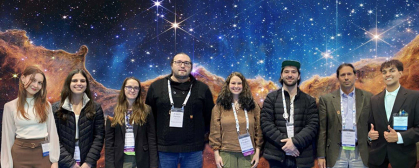Prodigious star formation by special galaxies reveals the Milky Way's origin story
Researchers led by a Rutgers University-New Brunswick astrophysicist, who looked deeply into space at a period known as "Cosmic Noon" about 2 billion to 3 billion years after the Big Bang, have found that a special class of galaxies were busy experiencing their first major burst of star formation.
The discovery is important, scientists said, because it will answer questions about how galaxies grow and evolve, providing key insights into the early stages of galaxy development and the overall history of the universe.
Reporting their findings in The Astrophysical Journal Letters, the team described crucial details uncovered about the star formation histories of ancient galaxies known as Lyman Alpha Emitters, or LAEs. To perform the study, scientists leveraged sophisticated imaging and machine learning techniques to look at Cosmic Noon, a period in the universe's history believed to be a peak era for galaxy development.
LAEs are galaxies that shine brightly because they are actively forming new stars. Ultraviolet light called "Lyman Alpha" is transformed into visible light as the universe expands, making these galaxies observable from Earth. LAEs are incredibly ancient, dating back more than 12 billion years, acting as cosmic beacons that help scientists understand the early universe.

Some members of astrophysicist Eric Gawiser's group include (from left) undergraduate student Bailey Thompson, doctoral student Danisbel Herrera, doctoral student Irene Moskowitz, former undergraduate student Joseph Santos, doctoral student Nicole Firestone, former undergraduate student George Kharchilava, Distinguished Professor Eric Gawiser and undergraduate student Govind Ramgopal.
"LAEs have been identified as progenitors of typical present-day galaxies like our own Milky Way," said Nicole Firestone, a National Science Foundation Graduate Research Fellow in the Department of Physics and Astronomy at the School of Arts and Sciences and the first author of the study. "Now that we know when they first formed their stars, we have discovered our own galaxy's 'origin story,' unlocking one of the mysteries of creation."
The original motivation for studying the ancient galaxies was to understand what the Milky Way galaxy looked like when it first started forming stars. Earlier research by Eric Gawiser, a Distinguished Professor in the Department of Physics and Astronomy, showed that LAEs will grow and evolve until they resemble the present-day Milky Way.
"Until now, it remained an open question whether we had looked far enough back in time to find the starting points for the Milky Way and galaxies like it," said Gawiser, who also led the research team behind the new finding. "Now we know the answer to that question is 'Yes!'"
Scientists have long wondered whether LAEs are galaxies experiencing their first burst of star formation or if they are older galaxies that have resumed star formation after a period of inactivity. This distinction is crucial for understanding the evolution of galaxies over cosmic time, the researchers said.
"For the very first time, we have been able to definitively show that most LAEs are experiencing their first major starburst at the time of observation and only have very young stars," Firestone said.
They used data from the ODIN project, a sky survey with a name that is an acronym for "One-hundred-deg2 DECam Imaging in Narrowbands." The project employs the Dark Energy Camera at the Cerro Tololo Inter-American Observatory in Chile. This camera captures specialized images of the distant universe over a large area of the sky.
The team identified LAEs as objects that appear much brighter in these specialized images compared with the colors of light visible to the human eye.
For the analysis, the researchers used a machine-learning technique to analyze the light from these galaxies to infer their physical properties, including the rate of star formation as a function of time. This method allowed them to reconstruct a detailed "life story" for each LAE in their sample. The method used for this was developed at Rutgers by Gawiser and Kartheik Iyer, a former graduate student who worked with the professor.
The study revealed that 95% of LAEs are at their peak star-forming phase. This result confirms that LAEs are in a crucial early stage of development, helping scientists understand the timeline and processes involved in galaxy formation, Firestone said.
The data are a stepping stone in revealing the precise conditions under which galaxies experience significant starbursts.
"This discovery helps us understand what our own Milky Way galaxy looked like when it first started forming stars," Gawiser said.






